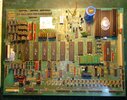Hi,
I've just produced my first PCB with around 250 holes and I'm so happy with it.
I used express pcb (and express plus for checking).
I'm in the UK so it wasn't viable to produce or ship a prototype over. Express were fantastic, I ordered the basic spec board and they sent me the gerbers. Great service.
I'm planning on a few bigger boards around 1200 holes and I think these will work out very expensive to get the gerbers.
So pricing it up I might be better paying for some software. I have a relatively poor 2014 win 10 laptop which is maxed out on Ram already.
That was my first CAD project, I'm a hobby person but technical enough... I'm hoping to remake old boards instead of repairing battery damage. No Old schematics available ... however I know enough to be able to work out alot of lines from I/Os and I'm seeing the benefits of partially adding a schematic if that makes sense (linking bus lines etc).
Can anyone recommend me a next step software.
Continuity/ trace highlight I can't live without for checking.
Thank You!
I've just produced my first PCB with around 250 holes and I'm so happy with it.
I used express pcb (and express plus for checking).
I'm in the UK so it wasn't viable to produce or ship a prototype over. Express were fantastic, I ordered the basic spec board and they sent me the gerbers. Great service.
I'm planning on a few bigger boards around 1200 holes and I think these will work out very expensive to get the gerbers.
So pricing it up I might be better paying for some software. I have a relatively poor 2014 win 10 laptop which is maxed out on Ram already.
That was my first CAD project, I'm a hobby person but technical enough... I'm hoping to remake old boards instead of repairing battery damage. No Old schematics available ... however I know enough to be able to work out alot of lines from I/Os and I'm seeing the benefits of partially adding a schematic if that makes sense (linking bus lines etc).
Can anyone recommend me a next step software.
Continuity/ trace highlight I can't live without for checking.
Thank You!

